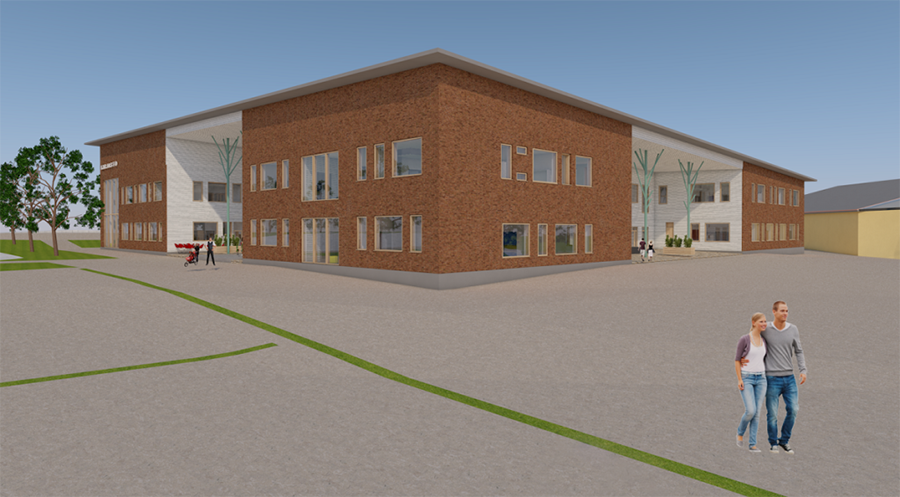
A municipality of 4,500 inhabitants, Tohmajärvi has recently begun the largest project in its history. From the beginning of 2021, the Tohmajärvi Centre of Education will offer schooling from preschool to general upper secondary school and leisure activities in its library, music institute and adult education centre.
Located close to the Russian border between Kitee and Joensuu, Tohmajärvi has started the largest project in its history this spring: the building complex under construction in the centre of Tohmajärvi will bring all the municipality’s educational services under one roof.
When complete, the Centre of Education will have close to 5,500 square metres of floor space and is designed to meet the needs of 350 students. The idea of combining cultural and educational services arose from a problem that, sadly, many municipalities are familiar with: its school buildings, which were built in the 60s and 70s, are reaching the end of their useful life.
“We knew that decisions about renovating the current school centre would have to be made within the next five years. We decided to deal with the problems at one stroke,” says Tohmajärvi municipality’s Director of Finance and Administration Vesa Karhapää.
The colossal contract is implemented with flexible real-estate leasing
At a cost of more than EUR 11 million, the contract is a huge project for a municipality the size of Tohmajärvi. The size of the project set its own challenges: financing the new Centre of Education with a traditional balance sheet loan would have exerted a considerable burden on the municipality’s self-sufficiency. That is why alternative solutions were sought from the outset.
“To our surprise, only one commercial bank was able to provide real-estate leasing as a financial solution for the project. The solution offered by Municipality Finance was so much more affordable that there was no question of acquiring funding from anywhere else,” says Karhapää.
Mika Korhonen, the Account Manager at MuniFin responsible for the project, says that flexible real-estate leasing is growing more and more popular year by year.
“We have been offering real-estate leasing for seven years, and there is no end in sight to its growing demand. This form of funding is particularly popular in small and medium-sized municipalities. The building of a school is a typical real-estate leasing project,” says Korhonen.
According to Korhonen, the contract period for real-estate leasing is adapted as far as possible to the buildings’ depreciation periods in the municipality. A typical lease period is 20 years, after which the municipality can either redeem the building at a price equivalent to its actual residual value, continue the leasing contract or resell the building.
The right partner can bring savings of millions
On the basis of the preliminary financing negotiations, it was clear that the project would exceed the EU-wide public procurement threshold set by the European Commission. This meant additional requirements for the project that, due to its size alone, would stretch the capabilities of the small municipality to the utmost.
To support the tendering process, MuniFin offered the municipality the services of its subsidiary Inspira. Inspira’s team of ten specialises in planning and implementing municipal and city investment projects and restructuring arrangements.
According to Ville Riihinen, the Inspira Director in charge of the project, utilising an expert partner can save a municipality a lot of money.
“In all our projects, we take advantage of the know-how we have gained over the years and our existing network of experts. At this very moment, we are running six major tendering processes for investment projects, involving more than ten buildings and totalling more than EUR 100 million in investment costs. Small municipalities, in particular, simply don’t have the experience for dealing with such processes. In major projects, choosing the right expert partner can save the municipality millions,” Riihinen sums up.
Partnering with Inspira in the Tohmajärvi contract are Ramboll, which is as an expert on technical matters, and the law firm Krogerus, an expert on legal matters.
“The partnerships were an excellent suggestion by Inspira. All three have such extensive experience in their own specialisms that they were able to provide us with ready-made templates for best practices and advice on what pitfalls to watch out for. Without such skilled partners we would have been in deep trouble,” Karhapää smiles.
The tendering process for the project was carried out through the negotiated procedure. During the eight-month process, various construction companies worked on their own plans in accordance with the guidelines and planning guidance provided by the municipality. Various user groups participated in the design of the Centre of Education, such as teachers, students and real estate maintenance providers.
The new Centre of Education is an investment in the future
In terms of paperwork, the colossal project is coming to an end, but the construction is only just beginning. In May, the work to cast the foundations of the centre began along the stretch of road named after the most famous daughter of Tohmajärvi, the singer Katri Helena.
For a municipality grappling with an ageing population, migration losses and an unbalanced employment structure, the Centre of Education is much more than the sum of its parts. The project is an integral part of a more vibrant Tohmajärvi than ever – and a major investment in its future.
“We hope that the Centre of Education will increase Tohmajärvi’s attractiveness, especially for families with young children. Our goal is to make Tohmajärvi a better home than ever – a place where everyone has the best possible conditions for living a rich, varied life,” Karhapää says.
Text: Roope Huotari